HiPACC Data Science Press Room. From: UCSC
The Data Science Press Room highlights computational and data science news in all fields *outside of astronomy* in the UC campuses and DOE laboratories comprising the UC-HiPACC consortium. The wording of the short summaries on this page is based on wording in the individual releases or on the summaries on the press release page of the original source. Images are also from the original sources except as stated. Press releases below appear in reverse chronological order (most recent first).
November 3, 2014 — NCI Cloud Pilot program to boost cancer genomics data sharing, accessibility
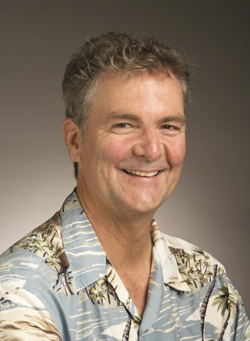
David Haussler, Director of the UC Santa Cruz Genomics Institute
UCSC 11/3/2014—The UC Santa Cruz Genomics Institute is part of a team led by the Broad Institute of Harvard and Massachusetts Institute of Technology that was awarded one of three National Cancer Institute (NCI) Cancer Genomics Cloud Pilot contracts. The goal of the project, which also involves scientists at UC Berkeley, is to build a system that will enable large-scale analysis of The Cancer Genome Atlas (TCGA) and other datasets by co-locating the data and the required computing resources in one cloud environment. This co-location will enable researchers across institutions to bring their analytical tools and methods to use on data in an efficient, cost-effective manner, thereby promoting democratization and collaboration across the cancer genomics community. The impetus for the cancer genomics cloud pilots grew from an inquiry the NCI posed in April 2013 asking the NCI grantee community to describe their most frequent computational challenges. From these responses, six general themes emerged: data access, computing capacity and infrastructure, data interoperability, training, usability, and governance.
View UCSC Data Science Press Release
October 29, 2014 — UC Santa Cruz offers ‘Genome Browser in a Box’ for local installations

Members of the UCSC Genome Browser team
UCSC 10/29/2014—Researchers at the UC Santa Cruz Genomics Institute have just made it easier to install a copy of the popular UCSC Genome Browser on a private computer. The browser has always been readily accessible online, providing a variety of tools for studying genome sequences. But some users require a local installation so they can use the UCSC Genome Browser with private or proprietary data. A new product, called the “Genome Browser in a Box,” enables individual scientists to install the browser on their own computers in about an hour. Previously, local installation of the browser was a laborious process requiring large amounts of server space. The UCSC Genome Browser is an efficient way to access and visualize publicly available information associated with particular genome sequences. The web-based browser is a portal to a database containing the genomes of about 100 species, including human, mouse, and fruit fly.
View UCSC Data Science Press Release
October 27, 2014 — Novel biosensor technology could allow rapid detection of Ebola virus
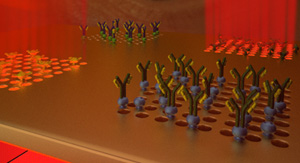
Proposed Ebola virus biosensor: The transmission of light through plasmonic nanohole arrays changes with the binding of specific proteins or virus particles.
UCSC 10/27/2014—Ali Yanik, assistant professor of electrical engineering, is focused on creating a low-cost biosensor that can be used to detect specific viruses without the need for skilled operators or expensive equipment. “We need a platform for virus detection that is like the pregnancy tests you can use at home,” Yanik said. He is focusing on the Lassa virus. Related to Ebola, it also causes hemorrhagic fever, which infects nearly half a million people every year in Africa and kills more people than Ebola, although it doesn’t make the news. Another major focus is the detection and isolation of circulating tumor cells in the blood of cancer patients, which spread cancer to other parts of the body (metastasis); thus, detecting them in blood samples can have important prognostic and therapeutic implications.
View UCSC Data Science Press Release
October 13, 2014 — UC Santa Cruz creates new Department of Computational Media
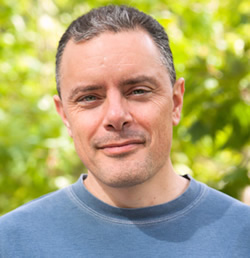
Michael Mateas is chair of the new Department of Computational Media. Credit: C. Lagattuta
UCSC 10/13/2014—With the creation of a Department of Computational Media in the Baskin School of Engineering, UC Santa Cruz has established an academic home for a new interdisciplinary field that is concerned with computation as a medium for creative expression. As a discipline, computational media combines the theories and research approaches of the arts and humanities with those of computer science to analyze, explore, and enable the computer as a medium for creative expression. The new department, which builds on the strong programs UC Santa Cruz has established in computer game design, is the first of its kind in the world, said Michael Mateas, chair of the department and director of the Center for Games and Playable Media at UCSC. In addition to games, other examples of computational media include social media, smart-phone apps, and virtual reality experiences. The common thread among all of them is that they require large amounts of computation and feature a level of interactivity that can only be created through computer technology. Said Mateas: “We’re seeing the birth of a fundamentally new form of expressive communication.”
View UCSC Data Science Press Release
October 9, 2014 — UC Santa Cruz leads $11 million Center for Big Data in Translational Genomics
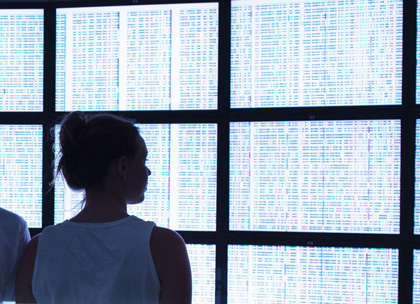
Credit: Elena Zhukova
UCSC 10/9/2014—The National Institutes of Health (NIH) has awarded $11 million to UC Santa Cruz to create the technical infrastructure needed for the broad application of genomics in medicine and biomedical research. This grant from the National Human Genome Research Institute (NHGRI) funds the Center for Big Data in Translational Genomics, a multi-institutional partnership based at UC Santa Cruz and led by David Haussler, professor of biomolecular engineering and director of the UC Santa Cruz Genomics Institute. The Center’s overarching goal is to help the biomedical community use genomic information to better understand human health and disease. To do this, scientists must be able to share and analyze genomic datasets that are orders of magnitude larger than those that can be handled by the existing infrastructure. Advances in DNA sequencing technology have made it increasingly affordable to sequence a person's entire genome, but managing genomic and related data from millions of individuals is a daunting challenge. The Center for Big Data in Translational Genomics will develop new protocols and tools for genomic data and test them in four pilot projects.
View UCSC Data Science Press Release
October 2, 2014 — Study of mountain lion energetics shows the power of the pounce
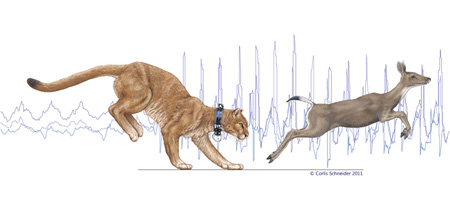
In the background of this illustration are typical SMART collar accelerometer traces for walking and then running, while the foreground shows a collared puma chasing a black-tailed deer. Credit: Corlis Schneider
UCSC 10/2/2014—Scientists at UC Santa Cruz, using a new wildlife tracking collar developed by a computer engineering graduate student, were able to continuously monitor the movements of mountain lions in the wild and determine how much energy the big cats use to stalk, pounce, and overpower their prey. The research team’s findings, published October 3 in Science, help explain why most cats use a “stalk and pounce” hunting strategy. The new Species Movement, Acceleration, and Radio Tracking (SMART) wildlife collar—equipped with GPS, accelerometers, and other high-tech features—tells researchers not just where an animal is but what it is doing and how much its activities “cost” in terms of energy expenditure. Understanding the energetics of wild animals moving in complex environments is valuable information for developing better wildlife management plans.
View UCSC Data Science Press Release
October 1, 2014 — UCSC Ebola genome browser now online to aid researchers’ response to crisis
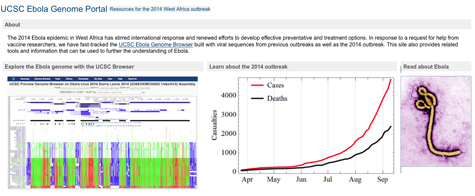
The UCSC Ebola Genome Portal contains links to the newly created Ebola browser and to scientific literature on the deadly virus.
UCSC 10/1/2014—A new Ebola bioinformatics tool—a genome browser to assist global efforts to develop a vaccine and antiserum to help stop the spread of the Ebola virus—was released on September 30 by the UC Santa Cruz Genomics Institute. UCSC has established the UCSC Ebola Genome Portal, with links to the new Ebola genome browser as well as links to all the relevant scientific literature on the virus. Scientists around the world can access the open-source browser to compare genetic changes in the virus genome and areas where it remains the same. The browser allows scientists and researchers from drug companies, other universities, and governments to study the virus and its genomic changes as they seek a solution to halt the epidemic. In a similar marshaling of forces in the face of a worldwide threat 11 years ago, UCSC researchers created a SARS virus browser.
View UCSC Data Science Press Release
September 24, 2014 — Human genome was shaped by an evolutionary arms race with itself

An evolutionary arms race has shaped the genomes of primates, including humans. Credit: David Greenberg
UCSC 9/28/2014— New findings by scientists at UC Santa Cruz suggest that an evolutionary arms race between rival elements within the genomes of primates drove the evolution of complex regulatory networks that orchestrate the activity of genes in every cell of our bodies. The arms race is between mobile DNA sequences known as “retrotransposons”—nicknamed “jumping genes”—and the genes that have evolved to control them. The UC Santa Cruz researchers have, for the first time, identified genes in humans that make repressor proteins to shut down specific jumping genes. The researchers also traced the rapid evolution of the repressor genes in the primate lineage. The study involved close collaboration between a “wet lab” for developing genetic assays and a “dry lab” where researchers used computational tools of genome bioinformatics to reconstruct the evolutionary history of primate genomes. Their findings are published in the September 28 issue of
Nature.
View UCSC Data Science Press Release
September 23, 2014 — UC Santa Cruz establishes Symantec Presidential Chair in Storage and Security

Ethan Miller directs the UC Santa Cruz Center for Research in Storage Systems. Credit: C. Lagattuta
UCSC 9/23/2014—A $500,000 gift to UC Santa Cruz from computer security company Symantec, plus matching funds from the UC Presidential Match for Endowed Chairs, will establish a $1 million endowment at UC Santa Cruz for the Symantec Presidential Chair in Storage and Security at UCSC’s Baskin School of Engineering. The endowed chair supports research and teaching in the engineering school’s Department of Computer Science, which has strong programs in computer security and data storage systems. Ethan Miller, professor of computer science and director of the Center for Research in Storage Systems at UC Santa Cruz, has been appointed as the inaugural holder of the new chair. The Baskin School of Engineering is home to world-class faculty in data storage systems and other key areas of data science. Symantec’s gift is a significant contribution to the Data Science Leadership Initiative of the $300-million Campaign for UC Santa Cruz.
View UCSC Data Science Press Release
September 22, 2014 — Linguists receive $260,000 grant to study endangered Irish language
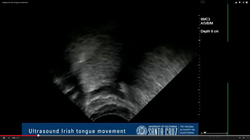
Screen shot of ultrasound of tongue of native Irish speaker
UCSC 9/22/2014—Even though the Irish language is an official language of Ireland and has considerable government support, it is highly endangered: only 1.5% to 3% of the population regularly uses it in their communities and its future is in doubt. One unusual feature of the Irish language is that every consonant comes in two varieties—one where the tongue is raised and pushed forward, and one where it is raised and retracted. So, one important goal of researchers is to document that contrast—using ultrasonic real-time tongue imaging to non-invasively capture video of the tongue’s surface while it moves during speech. UC Santa Cruz has been awarded a $261,255 grant from the National Science Foundation to undertake a new project titled “Collaborative Research: An Ultrasound Investigation of Irish Palatalization” to take the ultrasound machine to Ireland, record native speakers of Irish in three major dialect regions of Irish that are isolated from one another, and to analyze the data. Analysis of the ultrasound data will also allow them to answer more general questions about speech production.

View UCSC Data Science Press Release
September 19, 2014 — Library taps specialist to explore role of technology in humanities research
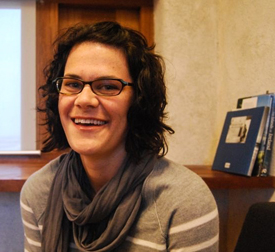
Rachel Deblinger
UCSC 9/19/2014—The UC Santa Cruz University Library and Humanities Division have jointly awarded a two-year Council on Library and Information Resources (CLIR) Postdoctoral Fellowship supporting digital humanities scholarship to Rachel Deblinger. As a CLIR Digital Humanities Specialist, Deblinger will have the opportunity to build a community around digital humanities scholarship at a time when the practice is emerging at UCSC. Collaborating with librarians, faculty and students across multiple divisions, Deblinger will explore online collaborative research practices supporting digital humanities and develop a pilot infrastructure to support this research. She will also examine the role of the University Library supporting digital humanities, conduct workshops, and help to facilitate graduate research. Previously at UCLA, she served as technical consultant on the development of a textual database supporting the publication of
Sephardic Lives: A Documentary History of the Ottoman Judeo-Spanish World and its Diaspora, 1700-1950; and was the thematic expert at the UCLA Center for Digital Humanities for the computational visualization of Shoah Foundation Holocaust testimonies.
View UCSC Data Science Press Release
September 11, 2014 — Teaching computers the nuances of human conversation
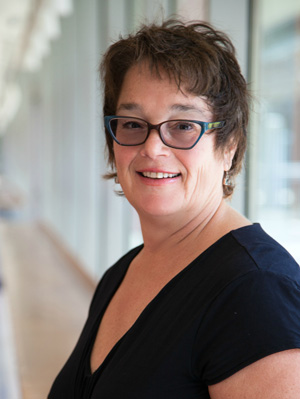
Marilyn Walker. Credit: C. Lagattuta
UCSC 9/11/2014—Natural language processing is now so good that the failure of automated voice-recognition systems to respond in a natural way has become glaringly obvious, according to Marilyn Walker, UC Santa Cruz professor of computer science. One of Walker’s current projects, funded last year by the National Science Foundation, involves analyzing posts from online debate forums to see how people present facts to support arguments. By annotating the online posts to uncover patterns in word choice and sentence construction, researchers seek to build a program that can identify sarcasm, report a poster’s stance on a topic, and identify the arguments and counter-arguments for a particular topic. Such software could also be useful as an educational tool: psychological evidence suggests that a debate becomes less polarized if people are exposed to multiple arguments. Also, by changing how computers talk, it may create an unspoken relationship that strengthens our connections to devices. Ultimately, such technology could be used to create companion robots, navigation programs, or restaurant recommendation software that interact with us more naturally.
View UCSC Data Science Press Release
August 7, 2014 — Cancer study reveals powerful new system for classifying tumors
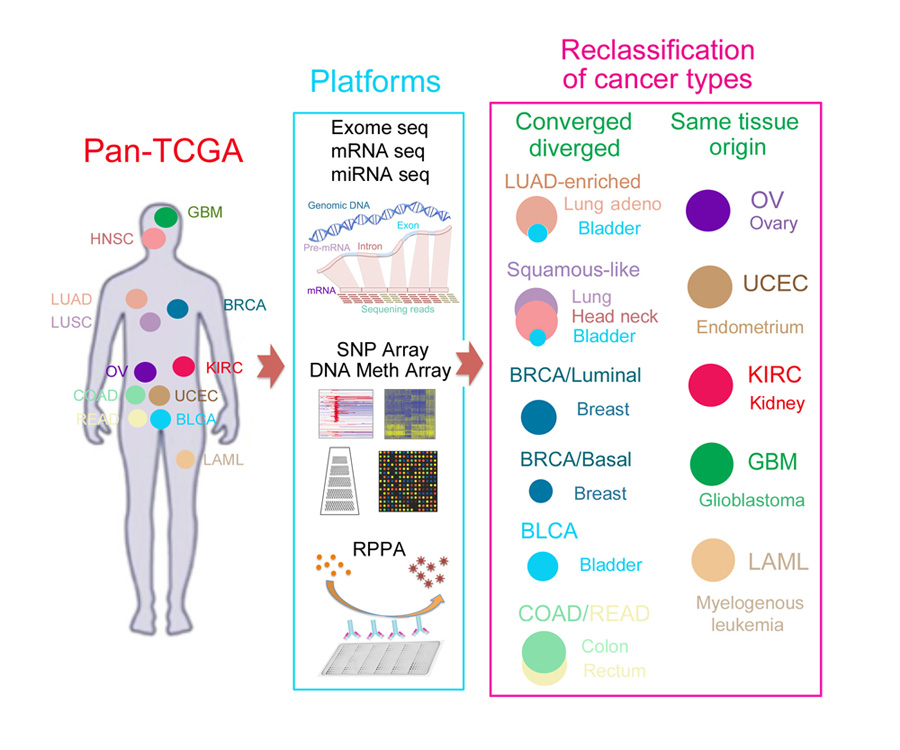
This diagram illustrates how tumors with different tissues of origin were reclassified on the basis of molecular analyses. Credit: Zhong Chen, NIH/NIDCD
UCSC 8/7/2014—Cancers are classified primarily on the basis of where in the body the disease originates, as in lung cancer or breast cancer. According to a new study, however, one in ten cancer patients would be classified differently using a new classification system based on molecular subtypes instead of the current tissue-of-origin system. This reclassification could lead to different therapeutic options for those patients, scientists reported in a paper published August 7 in Cell. The study involved an enormous amount of molecular and clinical data, which was managed by a software developer at UC Santa Cruz. UCSC researchers worked with the bioinformatics company Sage Bionetworks to create Synapse as a data repository for the Pan-Cancer Initiative. The data sets and results have been made available to other researchers through the Synapse web site.
View UCSC Data Science Press Release
July 31, 2014 — Global Alliance for Genomics and Health unveils new genomics interface

David Haussler directs the UC Santa Cruz Genomics Institute. Credit: R. R. Jones
UCSC 7/31/2014— The Global Alliance for Genomics and Health, founded in 2014, has released a new application programming interface (API) developed by the Global Alliance’s Data Working Group that will allow DNA data providers and consumers to better share information and work together on a global scale. David Haussler, professor of biomolecular engineering at UC Santa Cruz, is co-chair of the Data Working Group and a cofounder of the Alliance. The new open-source Genomics API, referred to as Version 0.5, is a standard, open tool promoting data interoperability, to allow the wider bioinformatics community to participate. “The Global Alliance is breaking new ground in combining genomic sequencing and clinical care,” said Matt Wood, general manager of data science for Amazon Web Services. “We view these new APIs as a vital component for collaboration and development of next-generation tools that can run cost-effectively at massive scale.”
View UCSC Data Science Press Release
July 7, 2014 — Two UC Santa Cruz earth scientists honored by American Geophysical Union

Gary Glatzmaier. Credit: J. MacKenzie
UCSC 7/7/2014—The American Geophysical Union (AGU) has awarded medals to two UC Santa Cruz scientists in recognition of their breakthrough achievements in Earth science. One of them, Gary Glatzmaier, professor of Earth and planetary sciences at UCSC, will receive the AGU’s John Adam Fleming Medal recognizing his research on Earth’s magnetic field and the geodynamo in Earth’s core that maintains it. Glatzmaier developed the first dynamically consistent computer simulations of the geodynamo, revealing the origin of the geomagnetic field and helping to explain reversals of the magnetic field seen in the geologic record. He has also developed numerical models to study the interiors of the sun and other stars, as well as giant gas planets like Jupiter and Saturn.
View UCSC Data Science Press Release
May 22, 2014 — CAFIN Spring Lecture: Finance at light speed, high-frequency trading
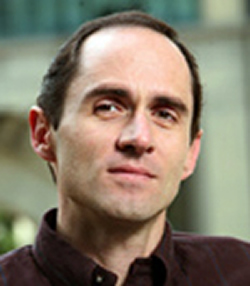
Terrence Hendershott
5/22/13 UCSC—Terrence Hendershott of the Haas School of Business at UC Berkeley spoke on “High Frequency Trading and the 2008 Short Sale Ban” for the Spring Lecture of the UC Santa Cruz Center for Analytical Finance (CAFIN). High-frequency trading and efforts to understand its consequences were recently the subject of the book Flash Boys. Hendershott was the visiting economist at the New York Stock Exchange in 2006 to 2007 and was a member of the Nasdaq Economic Advisory Board from 2004 to 2007 and chair in 2007. CAFIN is dedicated to exploring the challenge of improving financial intermediation in an interconnected, volatile world. Within CAFIN, economics professor Eric Aldrich has been working with Professor Gregory Laughlin, chair of the Astronomy and Astrophysics Department to devise fundamental new techniques for understanding the patterns of financial trading at high speeds. Their core insight is that the pattern of trading can be understood better by using trades as measures of time (“trade time”), rather than conventional “clock time.” This has immediate implications for broad topics such as market volatility, derivatives pricing, and potential for market failure.
View UCSC Data Science Press Release
May 20, 2014 — UCSC data storage researchers tackle practical problems

Rekha Pitchumani, a UCSC graduate student in computer science, has been working with Seagate on new data storage technology. Credit: Carolyn Lagattuta
UCSC 5/20/14—Rekha Pitchumani, a computer science graduate student in the Baskin School of Engineering at UC Santa Cruz, has been developing new data storage technologies at UCSC’s Storage Systems Research Center (SSRC) in collaboration with Seagate, a leader in the storage industry. Pitchumani has been working on shingled disk technology, developed to enable computer disk drives to store more information by overlapping the data tracks like roof shingles. To write data on a shingled disk, however, a computer needs new software, and updating large server farms with shingled disks requires a labor-intensive software upgrade for each server. Pitchumani wanted to simplify that process by developing data management software that could be placed directly on a shingled disk. Such “intelligent” disks could then manage themselves, eliminating the software installation step in upgrading server storage.
View UCSC Data Science Press Release
May 19, 2014 — Wireless camera network offers new possibilities for security systems

Computer engineering graduate student Kevin Abas designed the SWEETcam prototype.
UCSC 5/19/14—Advances in computer technology are opening up new possibilities for surveillance cameras and environmental video monitoring systems. Kevin Abas, a graduate student in computer engineering at UC Santa Cruz, used off-the-shelf components to build a prototype device for a solar-powered wireless network of smart cameras with potential applications in security systems and wildlife monitoring in remote areas. Abas described his system and reviewed similar designs developed by other researchers in a paper published as a cover feature in the May issue of the journal Computer, published by the IEEE Computer Society. ”The on-board components are getting so much smaller and more computationally powerful, it’s possible for a compact camera device to have a lot of data processing and other capabilities,” Abas said.
View UCSC Data Science Press Release

















